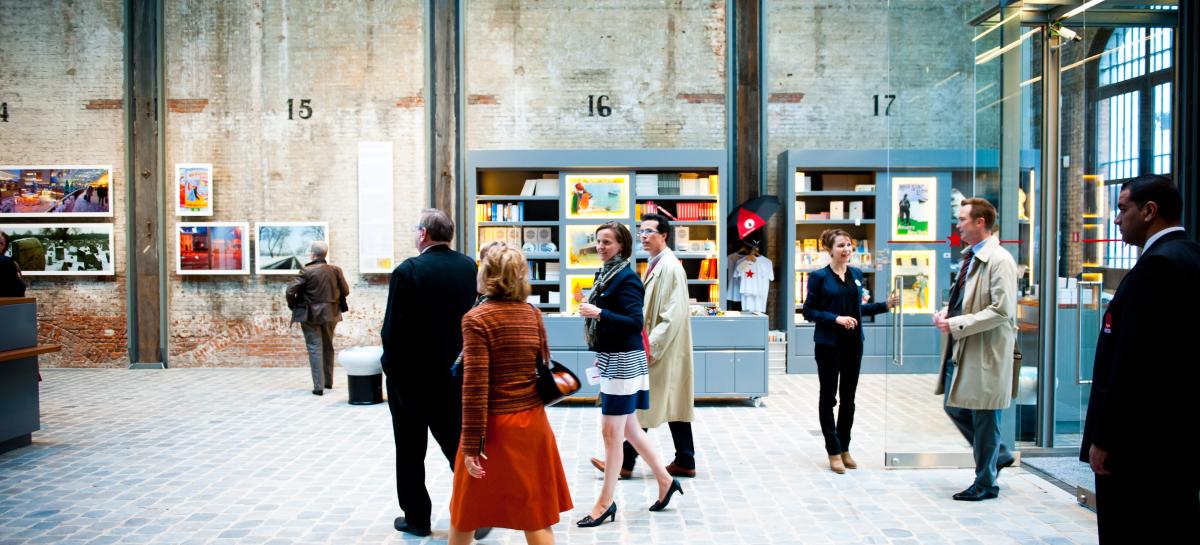1934-1992
Until 1934 the buildings along Rijnkaai were used as a medical and administrative control centre for steerage passengers travelling with the Red Star Line shipping company.
After the shipping company declared bankruptcy in 1934 the Red Star Line complex was renovated a couple of times in keeping with other uses after which it fell into disuse. The buildings and the shipping company’s history were soon forgotten.
In 1992 the Red Star Line collector Robert Vervoort petitioned the town council to put up a plaque on the Antwerp quays to commemorate the 120th anniversary of the founding of the company. At the time there was no mention of listing the buildings as heritage.
2000
The Antwerp town council agreed to list the monuments in the port and the Eilandje district as heritage. The list included the Montevideo sheds and De Shop as well as the Red Star Line buildings.
2001
The Government of Flanders listed two of the three Red Star Line sheds (RSL 2 and RSL 3) as heritage because of their "historic and industrial-archaeological value”.
2002
The National Maritime Museum organised the exhibition “Landverhuizers” about the history of the Red Star Line and migration through Antwerp. The first contacts were also established with the Ellis Island Foundation and the Ellis Island Immigration Museum in New York in this framework.
2004
After an exploratory study in Belgium and the United States, the town council established a project group which was asked to study the transformation of the buildings into a memorial with a "museum and educational function".
2005
The town council of Antwerp decided to purchase the Red Star Line buildings from the Antwerp Port Authority. After a procedure led by the Flemish Government Architect the New York-based architect’s firm Beyer Blinder Belle Architects & Planners LLP, in a consortium with the Antwerp-based engineering firm Arcade, was selected to design and develop the buildings.
2007
A memorandum of the scientific committee connected the local and historical story of the Red Star Line shipping company and its passengers with the universal phenomenon of human mobility.
The Flemish Minister Dirk Van Mechelen also listed the corner building, RSL 1, and the oldest of the three buildings, as heritage, after Red Star Line 2 and 3 had already been listed.
The town council approved the preliminary design by Beyer Blinder Belle Architects for the restoration of the three buildings.
The not-for-profit association Musea en Erfgoed became responsible for the project. In autumn of 2007 a team was put together which coordinated and prepared the new museum.
2008
AG Vespa was appointed as principal by the city and prepared a building project on behalf of the city to be funded by the city.
The architectural design was refined and a maximum budget set.
The Antwerp international maritime group, CMB (Compagnie Maritime Belge) became a sponsor of the Red Star Line Museum.
2009
A building permit was obtained.
2010
In its decision of 12 March, the Government of Flanders set out the final amount of the restoration grant. In the margin of the "Publiek Geheim” day by Belgian broadcaster VRT Canvas, the public could visit the dilapidated buildings one last time on 16 May.
The preparatory construction started on 17 May. The first phase included earthworks, the foundations and the construction of a cellar under RSL 2.
The contractor was THV Van Wellen-BMG. An official stone-laying ceremony was organised on 28 June.
2011
In March 2011 the preparatory foundation and structural works of the restoration of the buildings were completed. The actual restoration, phase two of the works, which was in hands of the contractor Strabag, started on 18 April.
Meanwhile, the Red Star Line Museum started to collect historical and contemporary stories about migration with a view to integrating them in the new museum. The Antwerp city archives also made these stories more accessible.
2012
The last year before the actual opening of the museum. One year prior to the opening, the public was invited one last time to see the buildings in their original state. Together with Antwerpen Open, the Red Star Line Museum organised a cultural festival from 28 April until 13 May with various cultural activities which evoked the atmosphere of the heyday of the Red Star Line. In September, the contractor Strabag completed the restoration of the warehouses. The tower was completed in December. In October, the work on the interior and the construction of the main exhibition started.
2013
On 27 September 2013, King Filip and Queen Mathilde officially inaugurated the museum. The Red Star Line Museum welcomed its first visitors the next day.


